Abstract
Pure Copper (Cu) is very difficult to prepare using selective laser melting (SLM) technology. This work successfully prepared the pure Cu with high relative density and high strength by the SLM technology using a surface oxidation treatment. The gas-atomized pure Cu powder was used as the feedstock in this work. Before the SLM process, the pure Cu powder was initially handled using the surface oxidation treatment to coat the powder with an extremely thin layer of Cu2O. The SLMed highly dense specimens contain α-Cu and nano-Cu2O phases. A relationship between the processing parameters (laser power (LP), scanning speed (SS), and hatch space (HS)) and density of Cu alloy in SLM was also investigated. The microstructure of SLMed Cu consists of fine grains with grain sizes ranging from 0.5 to ~30 μm. Tensile testing and detailed microstructural characterization were performed on specimens in the as-SLMed and pure copper state specimens. The mechanical property experiments showed that the specimens prepared by SLM technology containing nano-oxide phases had higher yield strength and tensile strength than that of other SLM-built pure copper. However, the elongation was remarkably decreased compared to other SLM-built pure copper, due to the fine grains and the nano-oxides.
1. Introduction
Selective laser melting (SLM), as one of the most promising additive manufacturing (AM) technologies based on powder bed fusion technology that produces metallic components with high relative density layer by layer using the laser as the input heat resource, brings tremendous opportunities for fabricating metallic components, especially those with complex structures [1,2,3]. Compared with traditional casting technology, SLM technology is highly precise and controllable, and can theoretically form arbitrarily shaped parts, allowing more complex and freer structures to be formed directly. SLM can improve the densification of formed parts by controlling the support size and tilt angle. Studying the effects of support size and tilt angle on the geometric properties of SLMed formed parts can help control the formation properties of the SLMed cellular lattice structure [4,5]. The SLM technology is widely recognized as a rapid prototyping technique with a delicate microstructure due to the high cooling speed, which might also generate a non-equilibrium solidification process. As a result of all the above mechanisms, it gives unique characteristics in the microstructures, phase, chemical composition, and mechanical properties [6,7]. There is no standard certification route for SLM forming quality and formability, and Li et al. investigated the certification lifecycle of laser powder bed melting for aerospace applications. A certification roadmap is proposed which provides insight into the qualification and certification of laser powder bed forming for aerospace applications and provides value for future industrial feasibility studies [8].
Copper and its alloys are widely used in electrical conductors and devices due to their excellent electrical and thermal conductivity [9,10]. With the rapid development of electrical industrials, requirements of copper and its alloy components not only focus on the electrical and thermal properties but also on the mechanical properties (such as higher strength) and structural complexity, which can be realized using SLM technology. The results of the Liu et al. study showed that the formation of pure copper on an aluminum-based substrate ensures the accumulation of heat, providing sufficient energy for the subsequent construction of the aluminum-based substrate. In theory this method is used for structural design and production to provide an idea [11]. However, there have been few attempts to form highly dense pure copper by SLM. The low-density parts resulted from insufficient laser energy deposited on powders due to their high thermal conductivity and low laser absorptivity [12,13].
In this study, gas-atomized pure Cu powder was treated using the minor surface oxidation approach to introduce a thin layer of Black Cu2O coating on the surface of the Cu powder. The surface-treated pure Cu with extremely thin Cu2O coatings were fabricated by SLM. Response surface methodology was adopted to optimize the process parameters to achieve the desired high relative density (RD). The mechanical properties were investigated using the specimens with the highest relative density among all the specimens prepared in this work. The relationship between the mechanical properties and microstructure was also analyzed in this work. At the same time, the mechanical properties were also compared with the SLMed pure copper fabricated by other researchers.
2. Experimental Procedures
2.1. Experimental Materials
In this study, the pure copper powder was prepared by the gas atomization technology and then oxidized by a constant temperature heating equipment to give the copper alloy powder a thin layer of oxide coating on its surface. The microstructure and elemental distribution of the powder were analyzed using scanning electron microscopy (SEM) and energy dispersive X-ray spectroscopy (EDS) (Hitachi TM 1000 desktop microscope, Hitachi High-Tech Group, Tokyo, Japan). Most of the powders exhibited a spherical shape, and the cellular grains can be found in the cross-sectional microstructure image of powder (Figure 1b). The size distribution of the powders was measured using the laser particle size analyzer (Tod Laser Particle Sizer, Zhuhai, China), which was in the range of 15~63 μm with an average size of 41 µm. The flowability and the apparent density of the powders were measured by the Hall flow apparatus. The measured flowrate was 1.32 s/50 g, and the apparent density of the powder was 4.25 g/cm3. Figure 1c–f shows the point energy spectrum of powders, and it can be seen that the oxygen content of the powder gradually decreases from the outside shell to the inner core, and the thickness of the oxide layer is less than 1 μm. Figure 1g shows the chemical composition of the powder. The oxygen element is evenly distributed, and the micro-oxidation on the surface of pure copper powder is relatively uniform.

Figure 1.
SEM images of the raw powders: (a) Surface morphology; (b) Cross section morphology; (c–f) Point energy spectrum of powders; (g) The chemical composition of the powder.
2.2. Experimental Design Method
The SLM specimens were prepared using EOS M100 (EOS GmbH, Krailling, Germany) SLM equipment. A Bi-directional scan strategy was applied with a layer thickness (t) of 20 μm. The Argon (Ar) gas was filled in the SLM chamber during the SLM process, and the O2 concentration in the atmosphere was kept below 1000 ppm. The response surface method (RSM) was used to optimize the SLM parameters (laser power (LP), scanning speed (SS), and hatch space (HS)), and the corresponding parameters were listed in Table 1. The values in Table 1 are the corresponding values taken for optimizing the process parameters in the response surface method [14]. In the SLM parameter optimization process, all specimens were fabricated at the dimensions of 10 × 10 × 6 mm3 in an argon atmosphere environment. The LP, SS, and HS were tailored to enhance the relative density (RD). A standard raster scanning strategy with a 67° rotation between two consecutive layers was employed. The layer thickness was kept constant at 20 μm and the substrate preheating temperature was 80 °C.

Table 1.
The value ranges of the processing parameters.
2.3. Characterization Methods
The RD of SLM-built specimens was measured using the Image-J software (1.47 v, National Institutes of Health, Bethesda, MD, USA) based on the microstructure images of the SLMed Cu on the side view taken by Optical microscopy (OM, Olympus-GX51, Olympus Corporation, Tokyo, Japan). The X-ray diffraction (XRD) patterns of specimens built by SLM were collected on a Rigaku Ultima IV X-ray diffraction (Rigaku Corporation, Tokyo, Japan). The microstructure of SLMed specimens was further characterized by SEM and electron backscattered diffraction (EBSD, FEIQUANTA FEG 650, FEI Company, Hillsboro, OR, USA). The mechanical properties were tested using an INSTRON 5985 electronic universal material testing machine with a strain rate of 10−3/s. The tensile specimens were prepared using the optimum SLM process parameters (LP 140 W, SS 400 mm/s, HS 0.05 mm, explained in the following section), and three specimens were measured for each case to ensure the accuracy of the experiments. The surfaces of the specimens were ground and polished using sandpaper with a grit of #200, #400, #600, #800, and #1000. The tensile direction was perpendicular to the building direction of the SLM specimen, which is parallel to the scanning plane. The detailed dimension of the tensile specimen is shown in Figure 2.
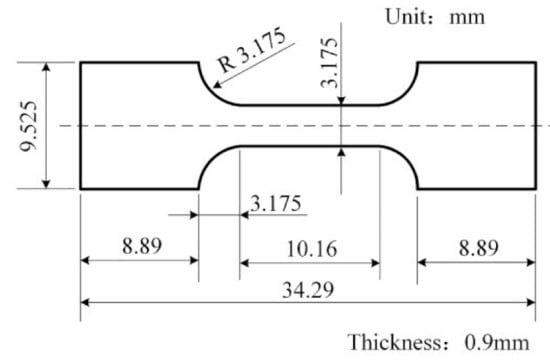
Figure 2.
The dimension of the tensile specimens.
3. Results and Discussion
In this paper, surface micro-oxidation of pure copper powder is carried out in air using a resistance furnace. The process was explored using a controlled variable method with a temperature setting of 160 °C and times of one minute, three minutes, and five minutes, respectively. As time increased, the powder oxygen content increased. When the heating time was increased from one to three minutes, the powder was oxidized more uniformly. However, as the time continued to increase, agglomeration of the powder was observed. This led to a decrease in the fluidity of the powder, which hindered the melting and forming of the powder. When comparing the surface micro-oxidation of pure copper powder, the best powder formation and the highest density were observed at a temperature of 160 °C and a heating time of 3 min.
The response surface methodology (RSM) shows the factorial contribution of the coefficients through a regression model and uses the input process variables and responses from the experimental data to identify the primary parameters, factors, and interactions. The RSM was used to optimize the experimental design using laser power, scan speed, and scan spacing as parameters. These parameters were varied simultaneously over several sets of experimental runs to identify the best process parameters to improve the output response [15].
The results of the response surface analysis are plotted in Figure 3a–c. The relative density of Cu specimen formed by SLM shows a trend of increasing initially and then decreasing with the increase of LP and SS. However, the relative density decreases with the increase of HS. The optimized parameters (LP = 140 W, SS = 400 mm/s, HS = 0.05 mm) are obtained from this response surface analysis.
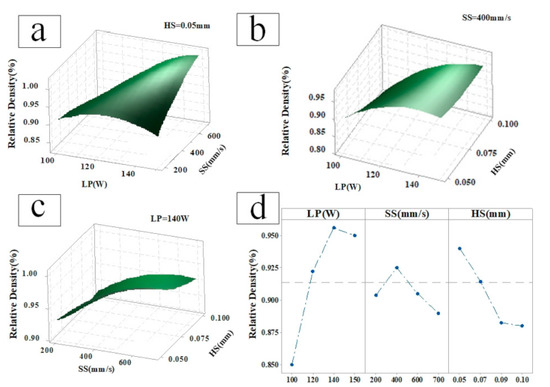
Figure 3.
Relative density of SLMed Cu under different parameters: (a) HS = 0.05 mm, (b) SS = 400 mm/s, (c) LP = 140 W, (d) Main effect plots.
Figure 3d shows the main effects of the LP, SS, and HS on the RD. The RD has the maximum value in the selected range of parameters. Within the selected parameter set, RD increases and then decreases with the increas of LP. The main effect of LP shows that when LP < 140 W, the powder is not fully melted and the specimen density increases with the increase of LP. When the powder is fully melted and the LP continues to increase (LP > 140 W), the instability of the melt pool increases [16,17], and the thermal stress in the specimen increases. The increase of thermal stress in the specimen leads to the generation of more defects. As a result, the relative density of the specimen is decreased.
From the diagram of SS effect, the specimen density increases and then decreases with the increase of the SS. This is because the lower the SS, the longer the laser action time on the a unit area of the powder bed, which gives the more laser energy absorbed in unit volume of powder, leading to the increase of the remelting depth. As a result, the liquid phase ratio in the melting pool increases and the melt viscosity decreases, leading to a severe fluid dynamics effect and more pores and defects in the melted pool [18,19,20]. If the SS is too slow, the same phenomenon of local superheating occurs, resulting in melt pool droplet spattering and poor surface quality. In this case, the tendency of spheroidization becomes serious, reducing the specimen densities. When the SS is greater than 400 mm/s, the remelting depth gradually decreases, the unmelted powder particles increase and the wetting effect of the melt pool decreases. The tendency of spheroidization increases, so that the specimen density gradually decreases.
As shown from the diagram of the HS effect, the RD gradually decreases with the increase of the HS. With the increase of HS, the lap area between adjacent single-channel gradually decreases, and the depth of groove between adjacent single-channel increases. As a result, the number of unmelted powder increases. The difference in powder layer thickness increases when scanning the next layer of powder. The amount of liquid phase of melt pool in a single-channel is not uniform, and the remelting depth in the same single channel is affected. This affects the density of the formed parts.
The phase compositions of the original pre-alloyed pure Cu powder, SLM formed pure Cu, surface micro-oxidized powder, and surface micro-oxidized pure Cu SLM formed parts were measured by X-ray diffractometer, and the diffraction patterns were obtained as shown in Figure 4. From Figure 4, the original powder and SLM formed pure copper consists of the Cu phase. Comparing the preparation process of the powder and the SLM forming process, both processes are air-cooled solidification forming after melting the material, and the cooling conditions are basically the same, thus forming a consistent phase composition from the solidification path. Their rapid solidifications both reach 103–108 K/s [21,22,23], which can significantly refine the organization, increase the solid solution of the alloy solute, and improve the mechanical properties of the alloy. Comparing the XRD patterns of SLM-formed pure copper and surface micro-oxidized pure copper, the XRD pattern of surface micro-oxidized pure copper produces a diffraction peak at 2θ = 36.5°, indicating that a new phase is formed in the powder molded parts after the surface micro-oxidation treatment, which can be determined as the Cu2O phase with reference to the standard peak.
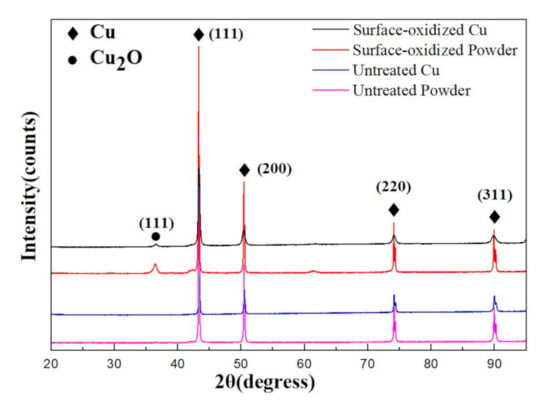
Figure 4.
XRD pattern of the Cu under the optimized SLM parameters.
Figure 5 shows the microstructure of the SLM-built surface micro-oxidized pure copper specimen. From the top surface of the specimen (Figure 5a), the microstructure of the SLM molded part shows the same structure of cellular crystal tissue as its powder. Figure 5b shows the histomorphology of the side of the specimen. The lateral tissue growth pattern is completely different from the top surface tissue pattern. The tissue shows extended growth along the direction of growth. A partial shift of the grain growth direction from the vertical direction is also observed, which can be attributed to the effect of moving laser thermal cycling action (scanning strategy) [24]. This epitaxial growth feature is commonly observed in other alloys formed by SLM, such as Cu-4.3Sn copper-tin alloys [25], Al-Cu-Mg [26] alloys, Cu-10Sn [27] alloys, etc.
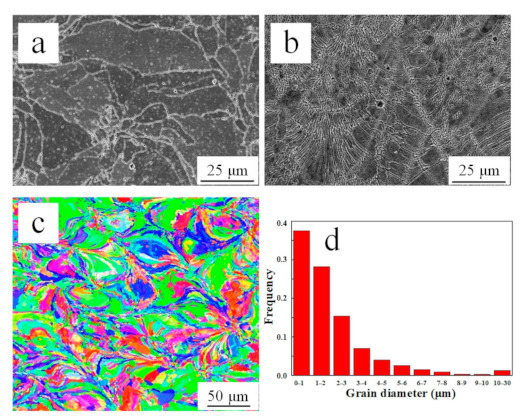
Figure 5.
Microstructures on top view of the surface micro-oxidized pure Cu SLM formed parts under the optimized SLM parameters: (a) top view, (b) side view, (c) IPF map, (d) Grain size distribution. The specimens were prepared using the optimum SLM process parameters (LP 140 W, SS 400 mm/s, HS 0.05 mm).
The EBSD analysis depicted in Figure 5c provides insights into the microstructural features and texture development in the surface micro-oxidized pure Cu SLM formed parts. Figure 5c shows the inverse pole figure (IPF) map on the top view, from which no obvious microtexture orientation can be found. Figure 5d shows the grain size plot with an average grain size of 2.034 μm, indicating that the surface micro-oxidized pure Cu SLM formed parts microstructure is composed of very fine grains. According to the fine grain strengthening mechanism [24], it can be demonstrated that the SLM process improves the mechanical properties (strength, hardness, plasticity) of the part mainly by the grain refinement, which can be attributed to the rapid melting and solidification characteristics of the process.
Stress–strain curves and tensile fracture morphologies are shown in Figure 6. Tensile properties are measured three times per specimen to ensure the accuracy of the experiment, and instead of measuring one specimen at random, a set of data close to the average is selected for the plotting of the stress–strain curve. Compared with the specimen parts without surface micro-oxidation treatment, the yield strength (σ0.2) and the UTS of the SLM fabricated specimens with surface micro-oxidation treatment are greatly improved. The quasi-static tensile yield strength (σ0.2) and the UTS of the specimen with surface micro-oxidation treatment increases from 115 MPa and 160 MPa (without surface micro-oxidation treatment) to 452 MPa and 549 MPa, respectively. The very limited introduction of Cu2O greatly improves the yield and tensile strength of the material at the expense of a limited drop of plasticity. The fracture surface morphology is analyzed as shown in Figure 6b. It shows a small number of dimple-like features, indicating that the failure is following the ductile fracture mechanism. The presence of a small number of oxides inside the dimples can also be observed in Figure 6b, and the presence of these oxides greatly increases the strength of the SLM-built Cu parts whose feedstock powders are pre-oxidized to form a thin Cu2O layer. The corresponding energy spectrum of point 1 in Figure 6b proves that the fine particles are oxide particles.
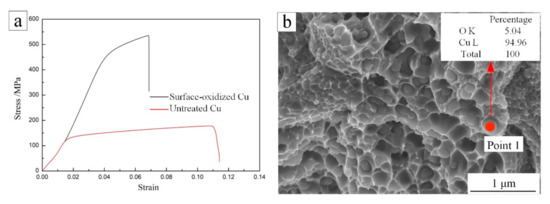
Figure 6.
The true stress–strain curves of SLMed Cu specimens (a), SEM images of the tensile fracture surfaces of the surface micro-oxidized pure Cu SLM formed parts (b). The tensile specimens were prepared using the optimum SLM process parameters (LP 140 W, SS 400 mm/s, HS 0.05 mm).
4. Conclusions
The melting of copper powder was improved by surface modification and the highly dense SLM-built pure Cu specimens were successfully prepared. This work provides a feasible solution to the preparation of highly dense pure copper using SLM technology. With the optimized SLM parameters, the tensile properties of the SLMed Cu in this work were greatly improved compared with other researchers’ work, due to its fine grain size, which is generated because of the Cu2O’s constraint during the consolidation process.
Author Contributions
Writing—original draft preparation, P.Y.; writing—review and editing, X.G.; funding acquisition, D.H.; methodology, Z.T. and W.S.; validation, H.F. All authors have read and agreed to the published version of the manuscript.
Funding
This research was funded by General Program of Science and Technology Development Project of Beijing Municipal Education Commission, grant number KM202010005006.
Informed Consent Statement
Informed consent was obtained from all subjects involved in the study. Written informed consent has been obtained from the patient(s) to publish this paper.
Data Availability Statement
Not applicable.
Conflicts of Interest
All authors declare that: (i) There’s no financial/personal interest or belief that could affect the objectivity of the submitted work; (ii) There are no other relationships or activities that could appear to have influenced the submitted work. (iii) The funders had no role in the design of the study; in the collection, analyses, or interpretation of data; in the writing of the manuscript, or in the decision to publish the results.
References
- Yadroitsev, I.; Smurov, I. Selective laser melting technology: From the single laser melted track stability to 3D parts of complex shape. Phys. Procedia 2010, 5, 551–560. [Google Scholar] [CrossRef] [Green Version]
- Zhang, J.; Song, B.; Wei, Q.; Bourell, D.; Shi, Y. A review of selective laser melting of aluminum alloys: Processing, microstructure, property and developing trends. J. Mater. Sci. Technol. 2018, 35, 270–284. [Google Scholar] [CrossRef]
- Mezghani, A.; Nassar, A.R.; Dickman, C.J.; Valdes, E.; Alvarado, R. Laser powder bed fusion additive manufacturing of copper wicking structures: Fabrication and capillary characterization. Rapid Prototyp. J. 2021, 27, 1181–1188. [Google Scholar] [CrossRef]
- Li, L.; Pan, T.; Zhang, X.; Chen, Y.; Cui, W.; Yan, L.; Liou, F. Deformations and stresses prediction of cantilever structures fabricated by selective laser melting process. Rapid Prototyp. J. 2021, 27, 453–464. [Google Scholar] [CrossRef]
- Zhang, B.; Han, X.; Chen, C.; Zhang, W.; Liao, H.; Chen, B. Effect of the strut size and tilt angle on the geometric characteristics of selective laser melting AlSi10Mg. Rapid Prototyp. J. 2021, 27, 879–889. [Google Scholar] [CrossRef]
- Gu, D.D.; Meiners, W.; Wissenbach, K.; Poprawe, R. Laser additive manufacturing of metallic components: Materials, processes and mechanisms. Int. Mater. 2013, 57, 133–164. [Google Scholar] [CrossRef]
- Thijs, L.; Verhaeghe, F.; Craeghs, T.; Humbeeck, J.V.; Kruth, J.P. A study of the microstructural evolution during selective laser melting of Ti–6Al–4V. Acta Mater. 2010, 8, 3303–3312. [Google Scholar] [CrossRef]
- Gibbons, W.D.; Serfontein, J.-P.L.; van der Merwe, A.F. Mapping the path to certification of metal laser powder bed fusion for aerospace applications. Rapid Prototyp. J. 2021, 27, 355–361. [Google Scholar] [CrossRef]
- Martin, H.; Ganser, A.; Eder, T.; Zäh, M.F. Laser welding of copper using a high power disc laser at green wavelength. Procedia CIRP 2018, 74, 446–449. [Google Scholar]
- Auwal, S.T.; Ramesh, S.; Yusof, F.; Manladan, S.M. A review on laser beam welding of copper alloys. Int. J. Adv. Manuf. Technol. 2018, 96, 475–490. [Google Scholar] [CrossRef]
- Guan, J.; Wang, Q.; Chen, C.; Xiao, J. Forming feasibility and interface microstructure of Al/Cu bimetallic structure fabricated by laser powder bed fusion. Rapid Prototyp. J. 2021, 27, 1337–1345. [Google Scholar] [CrossRef]
- Hess, A.; Schuster, R.; Heider, A.; Weber, R.; Graf, T. Continuous wave laser welding of copper with combined beams at wavelengths of 1030 nm and of 515 nm. Phys. Procedia 2011, 12, 88–94. [Google Scholar] [CrossRef] [Green Version]
- Constantin, L.; Fan, L.; Mortaigne, B.; Keramatnejad, K.; Zou, Q.; Azina, C.; Lu, Y.F.; Silvain, J.F. Laser sintering of cold-pressed Cu powder without binder use. Materialia 2018, 3, 178–181. [Google Scholar] [CrossRef]
- Zhou, Z.L.; Tan, Z.; He, D.Y.; Zhou, Z.; Cui, L.; Wang, Y.M.; Shao, W.; Wang, G.H. Fabrication of three-dimensional connected W-Cu10Sn composites by selective laser melting. Mater. Lett. 2020, 264, 127377. [Google Scholar] [CrossRef]
- Dada, M.; Popoola, P.; Mathe, N.; Pityana; Adeosun, S. Parametric optimization of laser deposited high entropy alloys using response surface methodology (RSM). Int. J. Adv. Manuf. Technol. 2020, 109, 2719–2732. [Google Scholar] [CrossRef]
- Gu, D.D.; Shen, Y.F. Balling phenomena in direct laser sintering of stainless steel powder: Metallurgical mechanisms and control methods. Mater. Des. 2009, 30, 2903–2910. [Google Scholar] [CrossRef]
- Guo, N.N.; Leu, M.C. Additive manufacturing: Technology, applications and research needs. Front. Mech. Eng. 2013, 8, 215–243. [Google Scholar] [CrossRef]
- Körner, C.; Bauereiß, A.; Attar, E. Fundamental consolidation mechanisms during selective beam melting of powders. Modell. Simul. Mater. Sci. Eng. 2013, 21, 5011. [Google Scholar] [CrossRef] [Green Version]
- Foroozmehr, A.; Badrossamay, M.; Foroozmehr, E.; Golabi, S. Finite Element Simulation of Selective Laser Melting process considering Optical Penetration Depth of laser in powder bed. Mater. Des. 2016, 89, 255–263. [Google Scholar] [CrossRef]
- Hussein, A.; Hao, L.; Yan, C.Z.; Everson, R. Finite element simulation of the temperature and stress fields in single layers built without-support in selective laser melting. Mater. Des. 2013, 52, 638–647. [Google Scholar] [CrossRef]
- Das, M.; Balla, V.K.; Basu, D.; Bose, S.; Bandyopadhyay, A. Laser processing of SiC-particle-reinforced coating on titanium. Scripta Mater. 2010, 63, 438–441. [Google Scholar] [CrossRef]
- Loh, L.E.; Chua, C.K.; Yeong, W.Y.; Song, J.; Mapar, M.; Sing, S.L.; Liu, Z.H.; Zhang, D.Q. Numerical investigation and an effective modelling on the Selective Laser Melting (SLM) process with aluminium alloy 6061. Int. J. Heat Mass. Transfer. 2015, 80, 288–300. [Google Scholar] [CrossRef]
- Li, X.P.; Wang, X.J.; Saunders, M.; Suvorova, A.; Zhang, L.C.; Liu, Y.J.; Fang, M.H.; Huang, Z.H.; Sercombe, T.B. A selective laser melting and solution heat treatment refined Al–12Si alloy with a controllable ultrafine eutectic microstructure and 25% tensile ductility. Acta. Mater. 2015, 95, 74–82. [Google Scholar] [CrossRef]
- Mao, Z.F.; Zhang, D.Z.; Jiang, J.J.; Fu, G.; Zhang, P. Processing optimisation, mechanical properties and microstructural evolution during selective laser melting of Cu-15Sn high-tin bronze. Mater. Sci. Eng. A 2018, 721, 125–134. [Google Scholar] [CrossRef] [Green Version]
- Ventura, A.P.; Wade, C.A.; Pawlikowski, G. Mechanical properties and microstructural characterization of Cu-4.3 Pct Sn fabricated by selective laser melting. Metall. Mater. Trans. A 2017, 48, 178–187. [Google Scholar] [CrossRef]
- Zhang, H.; Zhu, H.H.; Qi, T.; Hu, Z.H.; Zeng, X.Y. Selective laser melting of high strength Al-Cu-Mg alloys: Processing, microstructure and mechanical properties. Mater. Sci. Eng. A 2016, 656, 47–54. [Google Scholar] [CrossRef]
- Tan, Z.; Zhang, X.Y.; Zhou, Z.L.; Yang, Y.; Guo, X.Y.; Wang, Z.J.; Wu, X.; Wang, G.H.; He, D.Y. Thermal effect on the microstructure of the lattice structure Cu-10Sn alloy fabricated through selective laser melting. J. Alloys Compd. 2019, 787, 903–908. [Google Scholar] [CrossRef]
Publisher’s Note: MDPI stays neutral with regard to jurisdictional claims in published maps and institutional affiliations. |
© 2021 by the authors. Licensee MDPI, Basel, Switzerland. This article is an open access article distributed under the terms and conditions of the Creative Commons Attribution (CC BY) license (https://creativecommons.org/licenses/by/4.0/).